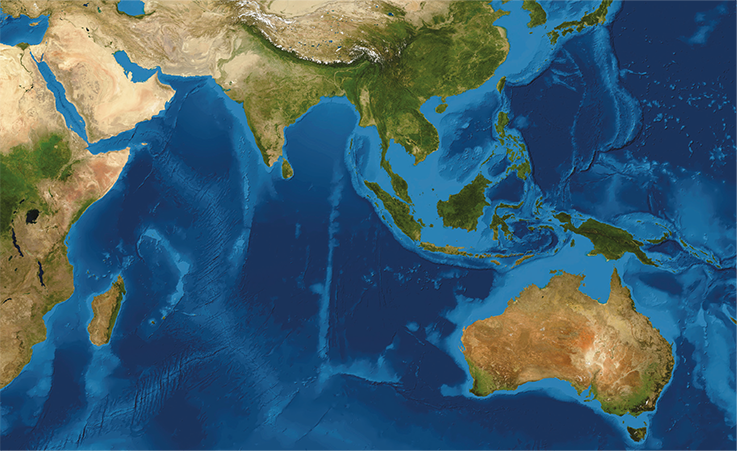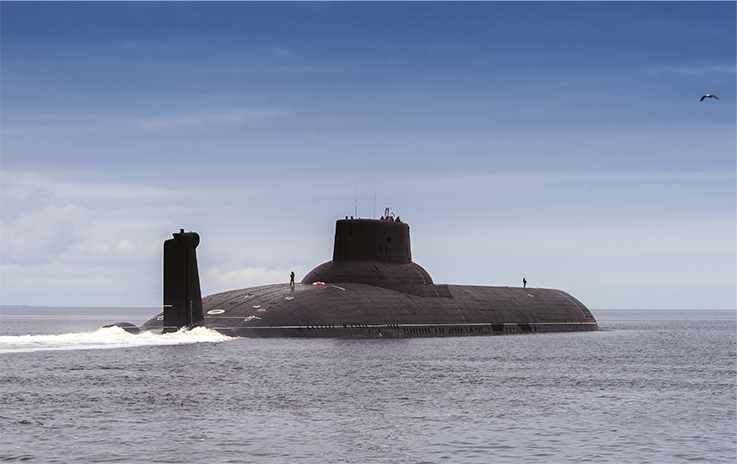Bringing cybersecurity globally to critical and complex key activities
> Countries List :
Solomon Islands, Fiji, Vanuatu, North Macedonia, Marshall Islands, Nauru, Guam, Caroline Islands, New Zealand, Australia
Contextual analysis of CIS and Geocyber risks
Oceania extends over a vast area of the Pacific Ocean, and encompasses different sub-regions made up of island states and island groups, including Melanesia (the Solomon Islands, Fiji and Vanuatu), Micronesia (Mariana Islands, Marshall Islands, Caroline Islands, Nauru and Guam), and the islands of Polynesia (Hawaii and Easter Island). It also includes New Zealand and Australia, larger countries which are more economically developed than the island states.
The region’s dynamics play out at Pacific-wide, sub-regional, and island levels. While Australia and New Zealand stand out as key countries thanks to their demographic and economic importance, the island states of Oceania are still over-dependent on other countries, leading to the development of a “north-south” divide in the region.
Largely ignored in the history of international relations, Oceania has emerged as a zone of significant strategic interest in the post-war period. Australia and New Zealand are seeking extensive US engagement in Oceania, while affirming their position as regional powers.
The decolonisation process has also focused attention on the challenges and vulnerabilities of small states in the region. The economic and political emergence of Asian powers has driven the development of closer links with Asia, and a stronger sense of belonging to the Asia-Pacific region.
While retaining ties with the UK and with their European heritage, Australia and New Zealand are also turning to the United States as a key security ally, evidenced notably in the AUKUS alliance in 2021, associated with the nuclear submarines scandal.
Main types of Attackers
_TENSIONS BETWEEN CHINA AND AUSTRALIA
Australia and China have adopted a more confrontational approach to each other.
In 2018, bilateral relations between Australia and China appeared to be at their lowest ebb for a decade when Australia ruled out Chinese telecom giant Huawei from building its 5G network on national security grounds. Over the year 2020, however, the relationship between the two countries has deteriorated even further, at a critical time for the region.
The ongoing degradation of relations between Canberra and Beijing throughout 2020 had unprecedented consequences for trade and economic links. On April 19, 2020, Scott Morrison’s government upped the stakes even further with its proposal for a global inquiry into China’s handling of the Covid-19 epidemic in Wuhan, thereby suggesting that China might be responsible for the global pandemic, and leading to an immediate response from the Chinese government.
Australia and China subsequently became embroiled in an escalation of trade disputes. Starting in May 2020, for example, China introduced a series of commercial sanctions against Australian products. The sanctions resulted in higher tariffs and stricter quotas being imposed on Australian products such as wine or barley.
In parallel with these commercial tensions, diplomatic disputes between the two countries also intensified. In May 2020, the Morrison government used its veto power to cancel Chinese investments that were to expand the New Silk Roads to the Oceanic continent, in the state of Victoria. In July 2020, Canberra promise to offer a safe haven to residents of Hong Kong after China rolled out its national security law to the city. The Chinese embassy in Australia responded by accusing Canberra of political interference in China’s internal affairs. In November 2020, Chinese Foreign Ministry spokesperson Zhao Lijian tweeted – via his official Twitter account – a controversial fake image depicting an Australian soldier holding a bloodied knife over the throat of an Afghan child. Canberra requested that China apologise for this attack on the conduct of Australian soldiers in Afghanistan, but received no reply.
This series of diplomatic incidents between the two countries must be viewed within the context of Australia’s broader security concerns about Chinese growth presenting a threat to the Asia-Pacific region. In response to the issue, Australia has consolidated its collaboration with allies and regional partners, such as the United States, the United Kingdom, Canada, New Zealand, Japan and India.
_ESCALATING ECONOMIC AND DIPLOMATIC TENSIONS IN 2020 BETWEEN CHINA AND AUSTRALIA HAVE ENCOURAGED OFFENSIVES BY CHINESE ATTACK GROUPS AGAINST AUSTRALIAN TARGETS, NOTABLY NATIONAL UTILITIES AND HOSPITALS
In June 2020, the Australian government issued an advisory on increased cyber activity by a state actor against networks belonging to its agencies and companies in the country. According to the Australian’s government, the attack was operated by a state-sponsored actor that relied on an exploit code which had been slightly modified for past vulnerabilities. Unofficially, China was blamed. The actor targeted public-facing infrastructure through the use of remote code execution vulnerabilities. This was the fourth warning in a year from the Australian Cyber Security Centre (ACSC) about threat actors exploiting critical vulnerabilities in Telerik UI (CVE-2019-18935, CVE-2017-9248, CVE-2017-11317, CVE-2017-11357). Exploit code had been publicly available for a while. If they failed to gain initial access by leveraging these flaws, the attacker turned to spear phishing to harvest credentials, deliver malware, and steal Office 365 OAuth tokens. A link to China is provided by the threat actor’s use of malware – such as PlugX – that has been associated with Chinese hacker groups, some believed to work on behalf of the government. Several actors, all connected to China and engaged in espionage activities, have PlugX in their toolset (ATK2, ATK37, ATK220, ATK41, and ATK15).
__NEW ZEALAND’S POSITION IN THE OCEANIA REGION
The intensification of tensions between China and Australia raises questions about New Zealand’s strategic positioning in this new context. On the one hand, the country is a historical ally of Australia and the trans-Tasman relationship was built around a common British colonial heritage. The two countries are part of the Commonwealth of Nations, the Five Eyes for strategic intelligence sharing, and have developed economic collaboration around the Closer Economic Relations (CER) free trade agreement. On the other hand, China accounts for nearly 30% of Australia’s exports and maintaining a peaceful bilateral relationship is critical to the sale of Australian dairy products overseas. In May 2020, the Five Eyes alliance (Canada, the United States, the United Kingdom, Australia and New Zealand) decided to broaden its prerogatives to allow for the display of a unique posture on issues related to democracy and fundamental human rights. In November 2020, this new role took shape when the alliance condemned China’s intervention in Hong Kong and called for the reinstatement of the members of the Legislative Council who had been suspended by Beijing. This declaration also denounced the treatment of the Uighur population.
While New Zealand Prime Minister Jacinda Ardern spoke of the difficulty of «reconciling» differences between the two countries, Foreign Minister Nanaia Mahuta refused to join the Five Eyes alliance’s condemnation of the treatment of the Uighur minority in Xinjiang province.
This statement, in addition to jeopardizing the alliance’s political project, shows the fragility of New Zealand’s diplomatic position, torn between preserving its relationship with Australia and its economic well-being. The progressive militarization in the South China Sea and Chinese interference in Hong Kong could lead New Zealand to adopt a clearer strategic line in the future. Depending on the positioning chosen, New Zealand could become a breeding ground for offensive activity by Chinese cyber attackers.

AUKUS (an acronym based on the country names Australia, United Kingdom and United States) is a new trilateral strategic defence alliance. It was initially created for the purpose of constructing a class of nuclear-powered submarines, collaborating in the Indo-Pacific region (where the rise of China is viewed as a growing threat), and developing more advanced technologies. The agreement led Australia to terminate the contract awarded to France in 2016 for the construction of 12 diesel-electric submarines to replace its ageing fleet of Collins-class submarines. Australia decided in November 2021 to engage alongside its American and British allies. Aside from the United Kingdom, this is the first time that the United States has shared nuclear propulsion technology with an ally. Consequently, many observers believe that Australia, the United Kingdom and the United States have entered into a historic nuclear defence and security agreement which will have consequences in the Indo-Pacific region for decades to come. The agreement will enable Australia to build a fleet of at least eight nuclear attack submarines in order to counter Chinese influence.
However, it is also interesting to note that the AUKUS agreement will include artificial intelligence as well as other technologies, such as cybersecurity. AUKUS could therefore be one of the most important defence and cooperation alliances for decades.
According to the associated press release, the partnership is a historic opportunity for the three nations to protect their shared values, and contribute to the stability and prosperity of the Indo-Pacific region, together with friends and partners who share the same ideas.
The decision to involve Australia in the longstanding cooperation between the US and the UK reflects the West’s growing concern about Beijing’s military expansion, debt diplomacy and cyber-intimidation.
_THE AUKUS ALLIANCE GOES WELL BEYOND JUST SUBMARINES
Attention has focused on French and Australian diesel/nuclear submarines, and military hardware is certainly a key component, in view of the geopolitical issues at stake. However, the agreement also covers other forms of conflict. The AUKUS alliance attaches particular importance to cyberspace.
At the press conference announcing the agreement, US president Joe Biden said that a cybersecurity component would be included, in addition to submarine technology. Although President Biden did not specify this during the press conference, it appears probable that the United States and the UK would support Australia in the deployment of cyber-defence, and potentially also cyber-attack, capabilities.
In recent years, Australia has been the target of several major cyber-attacks, one of the most striking of which took place in June 2020. Australian Prime Minister Scott Morrison went on the record to officially state that the country had been the subject of a sophisticated state-sponsored cyber-attack.
Suspecting that China was responsible, Mr Morrison said that he had talked to British Prime Minister Boris Johnson about the incident, although it is uncertain whether the United Kingdom had provided cyber-expertise to Australia.
